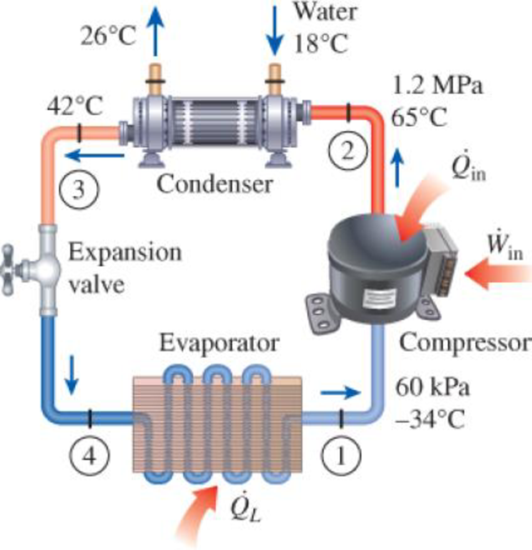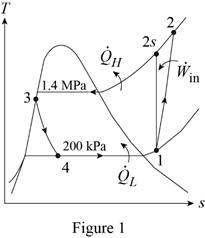
A commercial refrigerator with refrigerant-134a as the working fluid is used to keep the refrigerated space at −30°C by rejecting its waste heat to cooling water that enters the condenser at 18°C at a rate of 0.25 kg/s and leaves at 26°C. The refrigerant enters the condenser at 1.2 MPa and 65°C and leaves at 42°C. The inlet state of the compressor is 60 kPa and −34°C and the compressor is estimated to gain a net heat of 450 W from the surroundings. Determine (a) the quality of the refrigerant at the evaporator inlet, (b) the refrigeration load, (c) the COP of the refrigerator, and (d) the theoretical maximum refrigeration load for the same power input to the compressor.
FIGURE P11–22

(a)
The quality of the refrigerant at the evaporator inlet.
Answer to Problem 18P
The quality of the refrigerant at the evaporator inlet is
Explanation of Solution
Show the T-s diagram for the refrigeration cycle as in Figure (1).

Express specific enthalpy at state 3.
Here, specific enthalpy at saturated liquid and temperature of
Express the quality of the refrigerant at the evaporator inlet.
Here, specific enthalpy at saturated liquid and pressure of
Conclusion:
Perform unit conversion of pressure at state 1 from
Refer Table A-13, “superheated refrigerant-134a”, and write the value of specific enthalpy at state 1
Write the formula of interpolation method of two variables.
Here, the variables denote by x and y is initial temperature and specific enthalpy at state 1 respectively.
Show the specific enthalpy at state 2 corresponding to specific entropy as in Table (1).
|
Initial temperature |
Specific enthalpy at state 1 |
| 227.80 | |
| 240.78 |
Substitute
Perform unit conversion of pressure at state 2 from
Refer Table A-13, “superheated refrigerant-134a”, and write the value of specific enthalpy at state 2
Show the specific enthalpy at state 2 corresponding to temperature as in Table (2).
|
Temperature |
Specific enthalpy at state 2 |
| 289.66 | |
| 300.63 |
Use Excel by taking the values from Table (2), and using Equation (III) to get specific enthalpy at state 2.
Refer Table A-11, “saturated refrigerant 134a-temperature table”, and write the properties corresponding to temperature at state 3 of
Substitute
From Figure (1), write the specific enthalpy at state 3 is equal to state 4 due to throttling process.
Here, specific enthalpy at state 4 is
Refer Table A-12, “saturated refrigerant 134a-pressure table”, and write the properties corresponding to pressure at state 4 of
Substitute
Hence, the quality of the refrigerant at the evaporator inlet is
(b)
The refrigeration load.
Answer to Problem 18P
The refrigeration load is
Explanation of Solution
Express the mass flow rate of the refrigerant from an energy balance on the compressor.
Here, mass flow rate of the water is
Express the rate of heat supplied from the refrigerant.
Express compressor power input.
Here, rate of heat gained by compressor is
Express the refrigeration load.
Conclusion:
Refer Table A-4, “saturated water-temperature table”, and write the initial specific enthalpy of water corresponding to temperature of
Show the initial specific enthalpy of water corresponding to temperature as in Table (3).
|
Temperature |
Initial specific enthalpy of water |
| 15 | 62.982 |
| 18 | |
| 20 | 83.915 |
Use Excel by taking the values from Table (3), and using Equation (III) to get initial specific enthalpy of water.
Refer Table A-4, “saturated water-temperature table”, and write the initial specific enthalpy of water corresponding to temperature of
Show the initial specific enthalpy of water corresponding to temperature as in Table (3).
|
Temperature |
Final specific enthalpy of water |
| 25 | 104.83 |
| 26 | |
| 30 | 125.74 |
Use Excel by taking the values from Table (3), and using Equation (III) to get final specific enthalpy of water.
Substitute
Substitute
Substitute
Substitute
Hence, the refrigeration load is
(c)
The COP of the refrigerator.
Answer to Problem 18P
The COP of the refrigerator is
Explanation of Solution
Express the coefficient of performance of the refrigerator.
Conclusion:
Substitute
Hence, the coefficient of performance of the refrigerator is
(d)
The theoretical maximum refrigeration load.
Answer to Problem 18P
The theoretical maximum refrigeration load is
Explanation of Solution
Express the reversible COP of the refrigerator for the similar temperature limits.
Here, high and low source temperature is
Express the theoretical maximum refrigeration load.
Conclusion:
Substitute
Substitute
Hence, the theoretical maximum refrigeration load is
Want to see more full solutions like this?
Chapter 11 Solutions
THERMODYNAMICS(SI UNITS,INTL.ED)EBOOK>I
- PROBLEM 3.46 The solid cylindrical rod BC of length L = 600 mm is attached to the rigid lever AB of length a = 380 mm and to the support at C. When a 500 N force P is applied at A, design specifications require that the displacement of A not exceed 25 mm when a 500 N force P is applied at A For the material indicated determine the required diameter of the rod. Aluminium: Tall = 65 MPa, G = 27 GPa. Aarrow_forwardFind the equivalent mass of the rocker arm assembly with respect to the x coordinate. k₁ mi m2 k₁arrow_forward2. Figure below shows a U-tube manometer open at both ends and containing a column of liquid mercury of length l and specific weight y. Considering a small displacement x of the manometer meniscus from its equilibrium position (or datum), determine the equivalent spring constant associated with the restoring force. Datum Area, Aarrow_forward
- 1. The consequences of a head-on collision of two automobiles can be studied by considering the impact of the automobile on a barrier, as shown in figure below. Construct a mathematical model (i.e., draw the diagram) by considering the masses of the automobile body, engine, transmission, and suspension and the elasticity of the bumpers, radiator, sheet metal body, driveline, and engine mounts.arrow_forward3.) 15.40 – Collar B moves up at constant velocity vB = 1.5 m/s. Rod AB has length = 1.2 m. The incline is at angle = 25°. Compute an expression for the angular velocity of rod AB, ė and the velocity of end A of the rod (✓✓) as a function of v₂,1,0,0. Then compute numerical answers for ȧ & y_ with 0 = 50°.arrow_forward2.) 15.12 The assembly shown consists of the straight rod ABC which passes through and is welded to the grectangular plate DEFH. The assembly rotates about the axis AC with a constant angular velocity of 9 rad/s. Knowing that the motion when viewed from C is counterclockwise, determine the velocity and acceleration of corner F.arrow_forward
 Elements Of ElectromagneticsMechanical EngineeringISBN:9780190698614Author:Sadiku, Matthew N. O.Publisher:Oxford University Press
Elements Of ElectromagneticsMechanical EngineeringISBN:9780190698614Author:Sadiku, Matthew N. O.Publisher:Oxford University Press Mechanics of Materials (10th Edition)Mechanical EngineeringISBN:9780134319650Author:Russell C. HibbelerPublisher:PEARSON
Mechanics of Materials (10th Edition)Mechanical EngineeringISBN:9780134319650Author:Russell C. HibbelerPublisher:PEARSON Thermodynamics: An Engineering ApproachMechanical EngineeringISBN:9781259822674Author:Yunus A. Cengel Dr., Michael A. BolesPublisher:McGraw-Hill Education
Thermodynamics: An Engineering ApproachMechanical EngineeringISBN:9781259822674Author:Yunus A. Cengel Dr., Michael A. BolesPublisher:McGraw-Hill Education Control Systems EngineeringMechanical EngineeringISBN:9781118170519Author:Norman S. NisePublisher:WILEY
Control Systems EngineeringMechanical EngineeringISBN:9781118170519Author:Norman S. NisePublisher:WILEY Mechanics of Materials (MindTap Course List)Mechanical EngineeringISBN:9781337093347Author:Barry J. Goodno, James M. GerePublisher:Cengage Learning
Mechanics of Materials (MindTap Course List)Mechanical EngineeringISBN:9781337093347Author:Barry J. Goodno, James M. GerePublisher:Cengage Learning Engineering Mechanics: StaticsMechanical EngineeringISBN:9781118807330Author:James L. Meriam, L. G. Kraige, J. N. BoltonPublisher:WILEY
Engineering Mechanics: StaticsMechanical EngineeringISBN:9781118807330Author:James L. Meriam, L. G. Kraige, J. N. BoltonPublisher:WILEY





